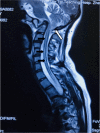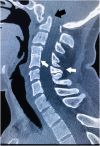Anesthetic management for cesarean delivery in a woman with congenital atlantoaxial dislocation and Chiari type I anomaly: a case report and literature review
- PMID: 33794807
- PMCID: PMC8017883
- DOI: 10.1186/s12884-021-03751-3
Anesthetic management for cesarean delivery in a woman with congenital atlantoaxial dislocation and Chiari type I anomaly: a case report and literature review
Abstract
Background: The preferable choice of anesthesia for the patients with congenital atlantoaxial dislocation (CAAD) and type I Arnold Chiari malformations (ACM-I) has been a very confusing issue in clinical practice. We describe the successful administration of combined spinal-epidural anesthesia for a woman with CAAD and ACM-1 accompanied by syringomyelia.
Case presentation: Our case report presents the successful management of a challenging obstetric patient with CAAD and ACM-1 accompanied by syringomyelia. She had high risks of difficult airway and aspiration. The injection of bolus drugs through the spinal or epidural needle may worsen the previous neurological complications. The patient was well evaluated with a multidisciplinary technique before surgery and the anesthesia was provided by a skilled anesthesiologist with slow spinal injection.
Conclusions: An interdisciplinary team approach is needed to weigh risks and benefits for patients with CAAD and ACM-1 undergoing cesarean delivery. Therefore, an individual anesthetic plan should be made basing on the available anesthetic equipments and physicians' clinical experience on anesthetic techniques.
Keywords: Anesthetic management; Cesarean section; Congenital atlantoaxial dislocation Arnold–Chiari malformation; Syringomyelia.
Conflict of interest statement
The authors declare that they have no competing interests.
Figures


References
-
- Walton Sir J. Brain’s diseases of the nervous system. 9. Oxford: Oxford University Press; 1985. pp. 412–416.
Publication types
MeSH terms
LinkOut - more resources
Full Text Sources
Other Literature Sources
Medical

